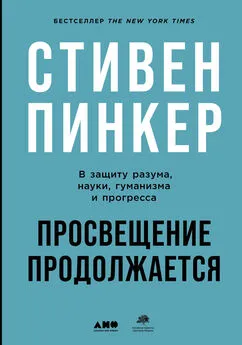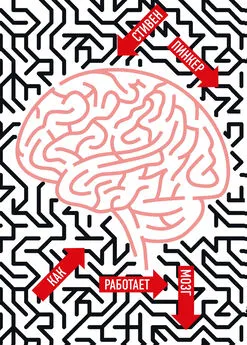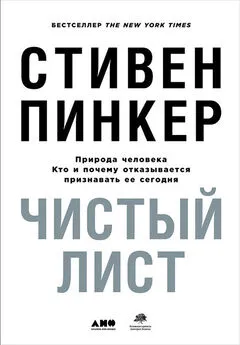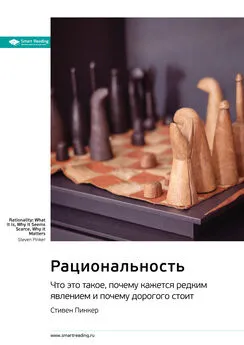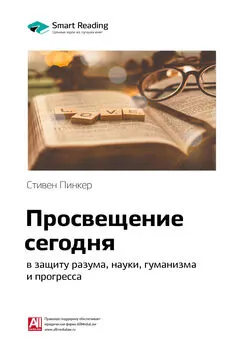Стивен Пинкер - Просвещение продолжается. В защиту разума, науки, гуманизма и прогресса
- Название:Просвещение продолжается. В защиту разума, науки, гуманизма и прогресса
- Автор:
- Жанр:
- Издательство:Альпина нон-фикшн
- Год:2021
- Город:Москва
- ISBN:9785001395362
- Рейтинг:
- Избранное:Добавить в избранное
-
Отзывы:
-
Ваша оценка:
Стивен Пинкер - Просвещение продолжается. В защиту разума, науки, гуманизма и прогресса краткое содержание
Этот прогресс – не случайность и не результат действия внешних сил. Это дар современному миру от деятелей Просвещения, которые первыми додумались, что знания можно использовать во имя процветания всего человечества. Идеи Просвещения – вовсе не наивные мечтания. Наоборот, они сработали – и это неоспоримый факт. Тем не менее именно сейчас эти идеи особенно нуждаются в нашей защите, поскольку противостоят характерным недостаткам человеческой природы – трайбализму, авторитаризму, демонизации чужаков и магическому мышлению, – которые так нравится эксплуатировать современным демагогам. Да, стоящие перед человечеством проблемы огромны, но все они решаемы, если мы, продолжая дело Просвещения, используем для этого разум, доверяем науке и руководствуемся идеалами гуманизма.
Особенности
Более 70 графиков из почти всех областей человеческой жизни.
Для кого
Для поклонников Стивена Пинкера. Для всех, кто интересуется природой человека. Для тех, кто верит в прогресс, и для тех, кто в нем сомневается.
Просвещение продолжается. В защиту разума, науки, гуманизма и прогресса - читать онлайн бесплатно ознакомительный отрывок
Интервал:
Закладка:
Dretske, F. I. 1981. Knowledge and the flow of information. Cambridge, MA: MIT Press.
Duarte, J. L., Crawford, J. T., Stern, C., Haidt, J., Jussim, L., & Tetlock, P. E. 2015. Political diversity will improve social psychological science. Behavioral and Brain Sciences, 38, 1–13.
Dunlap, R. E., Gallup, G. H., & Gallup, A. M. 1993. Of global concern. Environment: Science and Policy for Sustainable Development, 35, 7–39.
Duntley, J. D., & Buss, D. M. 2011. Homicide adaptations. Aggression and Violent Behavior, 16, 399–410.
Dutton, D. 2009. The art instinct: Beauty, pleasure, and human evolution . New York: Bloomsbury Press.
Eagen, K., Stolzenberg, E. B., Lozano, J. B., Aragon, M. C., Suchard, M. R., et al. 2014. Undergraduate teaching faculty: The 2013–2014 HERI faculty survey . Los Angeles: Higher Education Research Institute at UCLA.
Easterbrook, G. 2003. The progress paradox: How life gets better while people feel worse . New York: Random House.
Easterlin, R. A. 1973. Does money buy happiness? Public Interest, 30, 3–10.
Easterlin, R. A. 1981. Why isn’t the whole world developed? Journal of Economic History, 41, 1–19.
Easterly, W. 2006. White man’s burden: Why the West’s efforts to aid the rest have done so much ill and so little good . New York: Penguin.
Eastop, E.-R. 2015. Subcultural cognition: Armchair oncology in the age of misinformation. Master’s thesis, University of Oxford.
Eberstadt, N., & Shah, A. 2011. Fertility decline in the Muslim world: A veritable sea hange, still curiously unnoticed . Washington: American Enterprise Institute.
Eddington, A. S. 1928/2015. The nature of the physical world. Andesite Press.
Eibach, R. P., & Libby, L. K. 2009. Ideology of the good old days: Exaggerated perceptions of moral decline and conservative politics. In J. T. Jost, A. Kay, & H. Thorisdottir, eds., Social and psychological bases of ideology and system justification . New York: Oxford University Press.
Eichengreen, B. 2014. Secular stagnation: A review of the issues. In C. Teulings & R. Baldwin, eds., Secular stagnation: Facts, causes and cures . London: Centre for Economic Policy Research.
Eisner, M. 2001. Modernization, self ontrol, and lethal violence: The long erm dynamics of European homicide rates in theoretical perspective. British Journal of Criminology, 41, 618–38.
Eisner, M. 2003. Long erm historical trends in violent crime. Crime and Justice, 30, 83–142.
Eisner, M. 2014a. From swords to words: Does macro evel change in self ontrol predict long erm variation in levels of homicide? Crime and Justice, 43, 65–134.
Eisner, M. 2014b. Reducing homicide by 50 % in 30 years: Universal mechanisms and evidence ased public policy . In M. Krisch, M. Eisner, C. Mikton, & A. Butchart, eds., Global strategies to reduce violence by 50 % in 30 years: Findings from the WHO and University of Cambridge Global Violence Reduction Conference 2014 . Cambridge, UK: Institute of Criminology, University of Cambridge.
Eisner, M. 2015. How to reduce homicide by 50 % in the next 30 years . Rio de Janeiro: Igarapé Institute. Elias, N. 1939/2000. The Civilizing Process: Sociogenetic and psychogenetic investigations (rev. ed.). Cambridge, MA: Blackwell.
England, J. L. 2015. Dissipative adaptation in driven self ssembly. Nature Nanotechnology, 10, 919–23.
Epstein, A. 2014. The moral case for fossil fuels . New York: Penguin.
Epstein, G. 2009. Good without God: What a billion nonreligious people do believe . New York: William Morrow.
Ericksen, R. P., & Heschel, S. 1999. Betrayal: German churches and the Holocaust . Minneapolis: Fortress Press.
Erwin, D. 2015. Extinction: How life on Earth nearly ended 250 million years ago (updated ed.). Princeton, NJ: Princeton University Press.
Esposito, J. L., & Mogahed, D. 2007. Who speaks for Islam? What a billion Muslims really think . New York: Gallup Press.
Evans, D. 2015a. The great AI swindle. Edge . https://www.edge.org/response-detail/26073.
Evans, G. 2015b. Challenges for the Bulletin of the Atomic Scientists at 70: Restoring reason to the nuclear debate. Paper presented at the Annual Clock Symposium, Bulletin of the Atomic Scientists .
Evans, G., Ogilvie hite, T., & Thakur, R. 2014. Nuclear weapons: The state of play 2015 . Canberra: Centre for Nuclear Non roliferation and Disarmament, Australian National University.
Everett, D. 2008. Don’t sleep, there are snakes: Life and language in the Amazonian jungle . New York: Vintage.
Ewald, P. 2000. Plague time: The new germ theory of disease . New York: Anchor.
Faderman, L. 2015. The Gay Revolution: Story of a struggle . New York: Simon & Schuster.
Fariss, C. J. 2014. Respect for human rights has improved over time: Modeling the changing standard of accountability. American Political Science Review, 108, 297–318.
Fawcett, A. A., Iyer, G. C., Clarke, L. E., Edmonds, J. A., Hultman, N. E., et al. 2015. Can Paris pledges avert severe climate change? Science, 350, 1168–69.
Fearon, J. D., & Laitin, D. D. 1996. Explaining interethnic cooperation. American Political Science Review, 90, 715–35.
Fearon, J. D., & Laitin, D. D. 2003. Ethnicity, insurgency, and civil war. American Political Science Review, 97, 75–90.
Federal Bureau of Investigation. 2016a. Crime in the United States by volume and rate, 1996–2015. https://ucr.fbi.gov/crime-in-the-u.s/2015/crime-in-the-u.s.-2015/tables/table-1.
Federal Bureau of Investigation. 2016b. Hate crime. FBI Uniform Crime Reports. https://ucr.fbi.gov/hate-crime.
Federal Highway Administration. 2003. A review of pedestrian safety research in the United States and abroad: Final report . Washington: US Department of Transportation. https://www.fhwa.dot.gov/publications/research/safety/pedbike/03042/part2.cfm.
Federation of American Scientists. (Undated.) Nuclear weapons. https://fas.org/issues/nuclear-weapons/.
Feinberg, M., & Willer, R. 2011. Apocalypse soon? Dire messages reduce belief in global warming by contradicting just orld beliefs. Psychological Science, 22, 34–38.
Feldstein, M. 2017. Underestimating the real growth of GDP, personal income, and productivity. Journal of Economic Perspectives, 31, 145–64.
Ferreira, F., Jolliffe, D. M., & Prydz, E. B. 2015. The international poverty line has just been raised to $1.90 a day, but global poverty is basically unchanged. How is that even possible? http://blogs.worldbank.org/developmenttalk/international-poverty-line-has-just-been-raised-190-day-global-poverty-basically-unchanged-how-even.
Finkelhor, D. 2014. Trends in child welfare. Paper presented at the Carsey Institute Policy Series, Department of Sociology, University of New Hampshire.
Finkelhor, D., Shattuck, A., Turner, H. A., & Hamby, S. L. 2014. Trends in children’s exposure to violence, 2003–2011. JAMA Pediatrics, 168, 540–46.
Fischer, C. S. 2005. Bowling alone: What’s the score? Social Networks, 27, 155–67.
Fischer, C. S. 2006. The 2004 GSS finding of shrunken social networks: An artifact? American Sociological Review, 74, 657–69.
Fischer, C. S. 2011. Still connected: Family and friends in America since 1970 . New York: Russell Sage Foundation.
Fiske, A. P., & Rai, T. 2015. Virtuous violence: Hurting and killing to create, sustain, end, and honor social relationships . New York: Cambridge University Press.
Fletcher, J. 1997. Violence and civilization: An introduction to the work of Norbert Elias . Cambridge, UK: Polity.
Flynn, J. R. 2007. What is intelligence? New York: Cambridge University Press.
Flynn, J. R. 2012. Are we getting smarter? Rising IQ in the twenty rst century . New York: Cambridge University Press.
Foa, R. S., & Mounk, Y. 2016. The danger of deconsolidation: The democratic disconnect. Journal of Democracy, 27, 5–17.
Fodor, J. A. 1987. Psychosemantics: The problem of meaning in the philosophy of mind . Cambridge, MA: MIT Press.
Fodor, J. A. 1994. The elm and the expert: Mentalese and its semantics. Cambridge, MA: MIT Press.
Fogel, R. W. 2004. The escape from hunger and premature death, 1700–2100 . Chicago: University of Chicago Press.
Food Marketing Institute. 2017. Supermarket facts. https://www.fmi.org/our-research/supermarket-facts.
Foreman, C. 2013. On justice movements: Why they fail the environment and the poor. The Breakthrough, http://thebreakthrough.org/index.php/journal/past-issues/issue-3/on-justice-movements.
Fortna, V. P. 2008. Does peacekeeping work? Shaping belligerents’ choices after civil war . Princeton, NJ: Princeton University Press.
Fortna, V. P. 2015. Do terrorists win? Rebels’ use of terrorism and civil war outcomes. International Organization, 69, 519–56.
Foucault, M. 1999. The history of sexuality . New York: Vintage.
Fouquet, R., & Pearson, P. J. G. 2012. The long run demand for lighting: Elasticities and rebound effects in different phases of economic development. Economics of Energy and Environmental Policy, 1, 83–100. Francis. 2015. Laudato Si’: Encyclical letter of the Holy Father Francis on care for our common home . Vatican City: The Vatican. http://w2.vatican.va/content/francesco/en/encyclicals/documents/papa-francesco20150524enciclica-laudato-si.html.
Frankel, M. 2004. High noon in the Cold War: Kennedy, Khrushchev, and the Cuban Missile Crisis . New York: Ballantine Books.
Frankfurt, H. G. 2015. On inequality . Princeton, NJ: Princeton University Press.
Freed, J. 2014. Back to the future: Advanced nuclear energy and the battle against climate change . Washington: Brookings Institution.
Freilich, J. D., Chermak, S. M., Belli, R., Gruenewald, J., & Parkin, W. S. 2014. Introducing the United States Extremis Crime Database (ECDB). Terrorism and Political Violence, 26, 372–84.
Friedman, J. 1997. What’s wrong with libertarianism. Critical Review, 11, 407–67.
Fryer, R. G. 2016. An empirical analysis of racial differences in police use of force. National Bureau of Economic Research Working Papers, 1–63.
Fukuda, K. 2013. A happiness study using age eriod ohort framework. Journal of Happiness Studies, 14, 135–53.
Fukuyama, F. 1989. The end of history? National Interest, Summer.
Furman, J. 2005. Wal art: A progressive success story. https://www.mackinac.org/archives/2006/walmart.pdf.
Furman, J. 2014. Poverty and the tax code. Democracy: A Journal of Ideas, 32, 8–22.
Future of Life Institute. 2017. Accidental nuclear war: A timeline of close calls. https://futureoflife.org/background/nuclear-close-calls-a-timeline/.
Fyfe, J. J. 1988. Police use of deadly force: Research and reform. Justice Quarterly, 5, 165–205.
Gaillard, R., Dehaene, S., Adam, C., Clémenceau, S., Hasboun, D., et al. 2009. Converging intracranial markers of conscious access. PLOS Biology, 7, 472–92.
Gallup. 2002. Acceptance of homosexuality: A youth movement. http://www.gallup.com/poll/5341/Acceptance-Homosexuality-Youth-Movement.aspx.
Gallup. 2010. Americans’ acceptance of gay relations crosses 50 % threshold. http://www.gallup.com/poll/135764/Americans-Acceptance-Gay-Relations-Crosses-Threshold.aspx.
Читать дальшеИнтервал:
Закладка:
